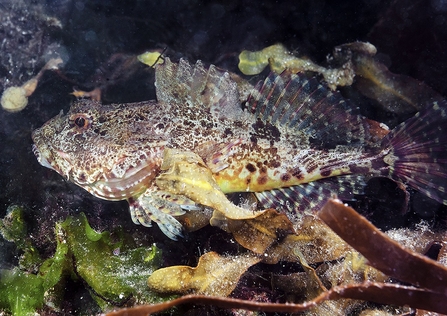
A long-spined sea scorpion was spotted in Earnse Bay, one of many intriguing marine sightings in 2023 © Mark Thomas
Gifting membership? Order by Wednesday 17 December in time for Christmas.

A long-spined sea scorpion was spotted in Earnse Bay, one of many intriguing marine sightings in 2023 © Mark Thomas
It’s been quite a turbulent year for wildlife in the Irish Sea, with some great conservation success stories, along with reminders of the threats that our marine wildlife faces. The marine team at Cumbria Wildlife Trust, with other North West Wildlife Trusts, is working hard to protect wildlife and habitats in the Irish Sea, and to bring people closer to nature on the coast. Here are their memorable marine moments from 2023, plus some intriguing sea sightings too.
Back in January 2023, we were delighted when a drone count revealed our highest grey seal count of the season at South Walney Nature Reserve, of 466. This showed that numbers have recovered well after a dip in 2022. This seal colony is recent – it’s developed from single figures since the 1980s - and this was only the ninth year in which the seals have bred.
Georgia de Jong Cleyndert, Head of Marine at North West Wildlife Trusts said: “This is Cumbria’s only breeding grey seal colony. With a lot of help from volunteers and local people, we've worked really hard to make this site safe and secure for the seals. This includes keeping disturbance to a minimum. It’s been a real conservation success story but we face ongoing challenges with disturbance. We urge everyone to help us ensure that the seals are not disturbed, so that they feel able to return here to breed in years to come.”
We were pleased to record nine seal pups this autumn, that’s an amazing 48 pups since 2015. But sadly pupping season was blighted by news of a number of disturbances of the colony. An adult seal and a porpoise were washed up, after possibly being hit by a boat. Another adult seal and pup were discovered dead at the same time. Their cause of death is unknown, but when mothers with pups are disturbed or alarmed, they flush into the water, potentially abandoning the new-born pups which can then starve.
Georgia said: “Defra, the wildlife tourism industry and conservationists have produced clear guidance for how sea users, including kayakers, anglers and operators of small boats, can all enjoy watching wildlife, if they do it in a responsible and wildlife-friendly way. They recommend that boats must keep at least 100m from seal colonies and we urge everyone to follow these important guidelines, to keep the colony safe.”
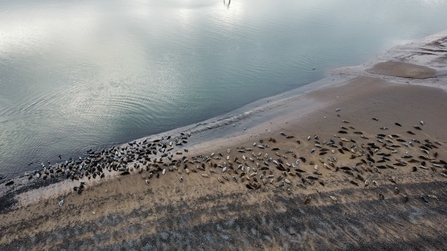
Seal colony at South Walney Nature Reserve from drone © Cumbria Wildlife Trust
The best way to see the seals is to follow us on social media and watch our live sealcam. Alternatively, visitors to South Walney can watch the seals in the sea at high tide from a safe distance in Groyne Hide, but there’s no access to the beach where the seals haul out.
In April there were some great marine mammal sightings at St Bees, where four harbour porpoises and two grey seals were spotted by a Sea Watch Survey, and around eight bottlenose dolphins were seen by one of our volunteers. Bottlenose dolphins are the biggest of their kind and the ones we’re most likely to see in the UK. They’re very sociable - look out for boisterous splashing and breaching – whereas harbour porpoises are shyer, spotted either alone or in small groups.
Some lucky wildlife watchers on the coastal path at St Bees saw not only a pod of seven to 10 bottlenose dolphins, but at the same time, witnessed a swarm of hundreds of barrel jellyfish. They’re the UK’s largest jellyfish, which can grow to the size of dustbin lids! In May, bottlenose dolphins were also seen from South Walney Nature Reserve, an exciting and very unusual sighting here.
Georgia explains: “Cetaceans (whales, dolphins and porpoises) are generally transient so sightings aren’t that common in our area. The prospect of seeing them is a great reason to join one of our Sea Watch events, but you may of course be lucky enough to spot them when out for a coastal walk!”
Sadly there was a more upsetting sighting at Seascale beach in March, when a young grey seal (possibly a 2022 pup from South Walney) was washed up, tangled in fishing gear. This sorry sight highlights the dangers of marine and beach litter, especially from fishing boats. Georgia said: “Ghost gear is fishing gear such as nets, pots and lines which have become lost, discarded or abandoned at sea. This gear continues to needlessly catch and kill marine life, such as seals. Lost fishing gear is one of the most common types of marine litter found in the sea today. We run regular beach cleans around the coast to help to clear up marine litter. Why not get involved?”
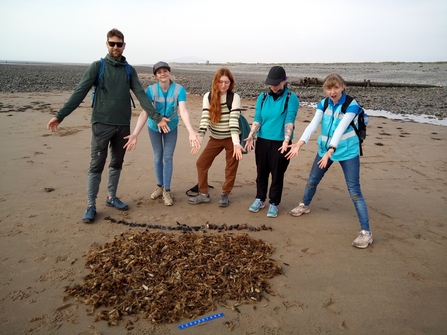
Shoresearchers found a huge number of ray and shark egg cases off Walney © Cumbria Wildlife Trust
While you may not think of sharks swimming around the coast in Cumbria, a huge haul of their egg cases off the coast at Biggar Bank, Walney Island may make you think again. In April, a group of shore-searchers took part in an Easter egg hunt, looking for egg cases (also known as mermaid’s purses) discarded by sharks and rays. These small brown or black pods can sometimes be mistaken for seaweed. The egg hunters found no less than 3,759 egg cases, a huge number in one search! This included cases from small spotted catsharks, nursehound sharks, thornback ray and spotted ray. This beats last year’s top haul of 3,316 and suggests that these ray and shark populations are very healthy.
Shark and ray egg-case hunts are just one of the community activities you can do on the coast with The Bay, a joint Nature and Wellbeing Programme we’re involved with in Morecambe Bay - keep an eye on The Bay website. During 2023 the project has drawn nearly 6,000 people to The Bay community events and nearly 300 people have been referred by health care providers or by themselves to enjoy the coast to improve their mental health.
This year we trialled a new way of monitoring shark populations in our area. We worked with two local fisherman using creels and sent down BRUVs (Baited Remote Underwater Video) in the West of Walney Marine Conservation Zone. It was successful; the GoPro camera on the creel gave us footage of a number of species, including a lesser spotted catshark coming to check out the bait.
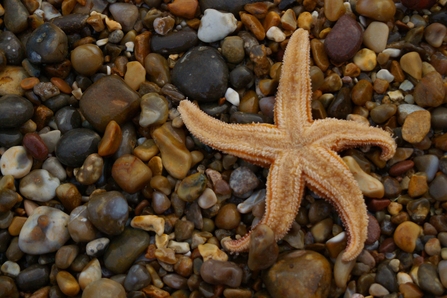
Starfish © Neil Aldridge
While common around the UK, an unusual sighting for Cumbria was a sea scorpion, spotted at a Shoresearch in Earnse Bay in May. It's in fact a fish, which gets its name from the long spines attached to various parts of its body. Masters of disguise, this species exhibits one of the best examples of camouflage you’ll find on the seashore! It has amazing mottled colouration and can change its colour to blend in perfectly with its background. A top predator, it gulps up crabs and fish with its huge mouth.
Less welcome were increased sightings of Pacific oysters, on the west and south coast of Cumbria. While sightings are irregular, they’re becoming more common and are a cause for concern as they’re an invasive species and out-compete native oysters and other wildlife for food and space.
Mass strandings of marine wildlife are not uncommon in bad weather and in November’s storms, thousands of starfish washed up on the beach at South Walney Nature Reserve. Starfish can be washed up as they live on soft, sandy parts of the ocean floor and are easily picked up by currents and waves. This ‘starballing effect’ can be beneficial to get them swept to new feeding and breeding grounds but also makes them particularly susceptible to being washed up during stormy weather. As a result, the resident herring gulls and black-backed gulls, whose numbers have bounced back in recent years, were treated to a feast lasting several days.
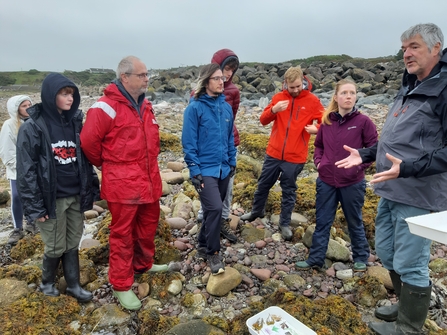
Marine champions being trained in 2023 © Cumbria Wildlife Trust
As well as protecting wildlife, our marine team has been busy this year bringing people closure to nature on the coast. We’ve trained a group of volunteers as Marine Champions – they’ll be organising public events for us about the wonders of our coastal wildlife, such as Shoresearches and Sea Watches. We’ll be training more Marine Champs in spring 2024.
In June we started a brand new venture for us: snorkel safaris, at Parton on the Solway. These immersive events gave a completely new outlook on the Cumbrian coastal waters, which are often seen as murky and lifeless, by allowing participants to experience the shallow seas in their full glory. A fantastic range of wildlife was spotted, in crystal-clear water, including enormous barrel jellyfish, cheeky shore crabs, colourful cuckoo wrasse and hand-sized starfish, as well as a beautiful array of seaweeds drifting in the tide. We’ll be repeating these popular events in 2024 – keep an eye on the events page of our website.
In July, our ever-popular SeaFest welcomed hundreds of people on the beach at St Bees, to take part in a fun day of marine-themed activities. This event will return in an exciting new format in July 2024 – watch this space!
Finally, March 2023 marked a real high point in marine conservation: Allonby Bay was confirmed as one of just three UK Highly Protected Marine Areas. This designation will give the highest level of protection, with only non-damaging activities, such as swimming, kayaking and scuba diving, allowed in this area. There’ll be no fishing, construction or digging in the protected area, giving nature the best chance of recovery (there’ll be zones where local anglers will still be able to fish from the beach without causing damage to the reefs).
Georgia explains why Allonby Bay is important: “There are several key species and habitats here, including honeycomb worm reefs and blue mussels. It’s an important spawning and nursery ground for commercially-important fish species, such as bass and thornback rays, and there’s anecdotal evidence that the area is a potential pupping ground for harbour porpoise, with mothers and young calves frequently seen in the area.”
However, Georgia says the Wildlife Trusts want to see a lot more of the UK coastline protected in this way: “This designation for Allonby Bay is just one step in the right direction. We look forward to more designations right across the country, in order to protect our marine environment, which is under significant and increasing pressure.”
Honeycomb worm reef at Allonby Bay © NWIFCA